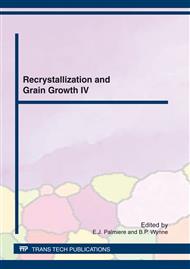[1]
Randle V., (2004) Twinning-related grain boundary engineering (overview), Acta Mater., 52, 4067-4081.
DOI: 10.1016/j.actamat.2004.05.031
Google Scholar
[2]
B. Reed, M. Kumar, W. R. Minich and R. E. Rudd: Acta. Mater., 2008, 56, 3278.
Google Scholar
[3]
21. D.S. Lee, H.S. Ryoo and S.K. Hwang: Mater. Sci. Eng., 2003, A354, 106.
Google Scholar
[4]
Saylor DM, El-Dasher BS, Rollett AD, Rorher GS. Acta Mater 2004; 52: 3649.
Google Scholar
[5]
Randle V., Rohrer G., Kim C. and Hu Y, (2006) Changes in the five-parameter grain boundary character distribution in alpha-brass brought about by iterative thermomechanical processing. Acta Mater., 54, 4489-4502.
DOI: 10.1016/j.actamat.2006.05.035
Google Scholar
[6]
D. P. Field, L.T. Bradford, M. M. Nowell and T. M. Lillo: Acta. Mater., 2007, vol. 55, pp.4233-41.
Google Scholar
[7]
Owen GT and Randle V, (2006) On the role of iterative processing in grain boundary engineering, Scripta Mater., 55, 959-962.
DOI: 10.1016/j.scriptamat.2006.04.049
Google Scholar
[8]
M. Shimada ∗, H. Kokawa, Z.J. Wang, Y.S. Sato, I. Karibe Acta Materialia 50 (2002) 2331–2341.
DOI: 10.1016/s1359-6454(02)00064-2
Google Scholar
[9]
K. Kashihara and F. Inoko: Acta. Mater., 2001, vol. 49, pp.3051-61.
Google Scholar
[10]
B. Alexandreanu, B. H. Sencer, V. Thaveeprungsriporn and G. S. Was: Acta. Mater., 2003, vol. 51, pp.3831-48 L. Lu, Y. Shen, X. Chen, L. Qian and K. Lu: Science, 2004, vol. 304, pp.422-26.
Google Scholar
[11]
Lu L Shen Y Chen X Qian L Lu K. Science 2004; 304: 422.
Google Scholar
[12]
E. M. Lehockey and A. M. Brennenstuhl: Corrosion Science, 2004, vol. 46 (10), pp.2383-2404.
Google Scholar
[13]
Randle V. and Coleman M., (2009) A study of low-strain and medium-strain grain boundary engineering. Acta Mater., 57, 3410-3421.
DOI: 10.1016/j.actamat.2009.04.002
Google Scholar
[14]
Coleman M. and Randle V. (2009) Changes in interface parameters and tensile properties as a consequence of iterative processing. Met. Mater. Trans. A., 39, 2175-2183.
DOI: 10.1007/s11661-008-9574-6
Google Scholar
[15]
W. J. Babyak, F. N. Rhines: TMS-AIME., 1960, vol. 218, pp.21-23.
Google Scholar
[16]
L. Tan, K. Sridharan and T.R. Allen: J. Nucl. Mater., 2007, 371, 171.
Google Scholar
[17]
W.Z. Jin, S. Yang, H. Kokawa, Z.J. Wang, Y.S. Sato: J. Mater. Sci. and Tech., 2007, 23, 785.
Google Scholar


